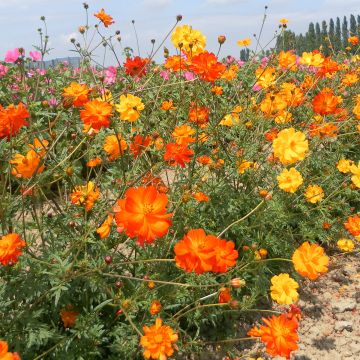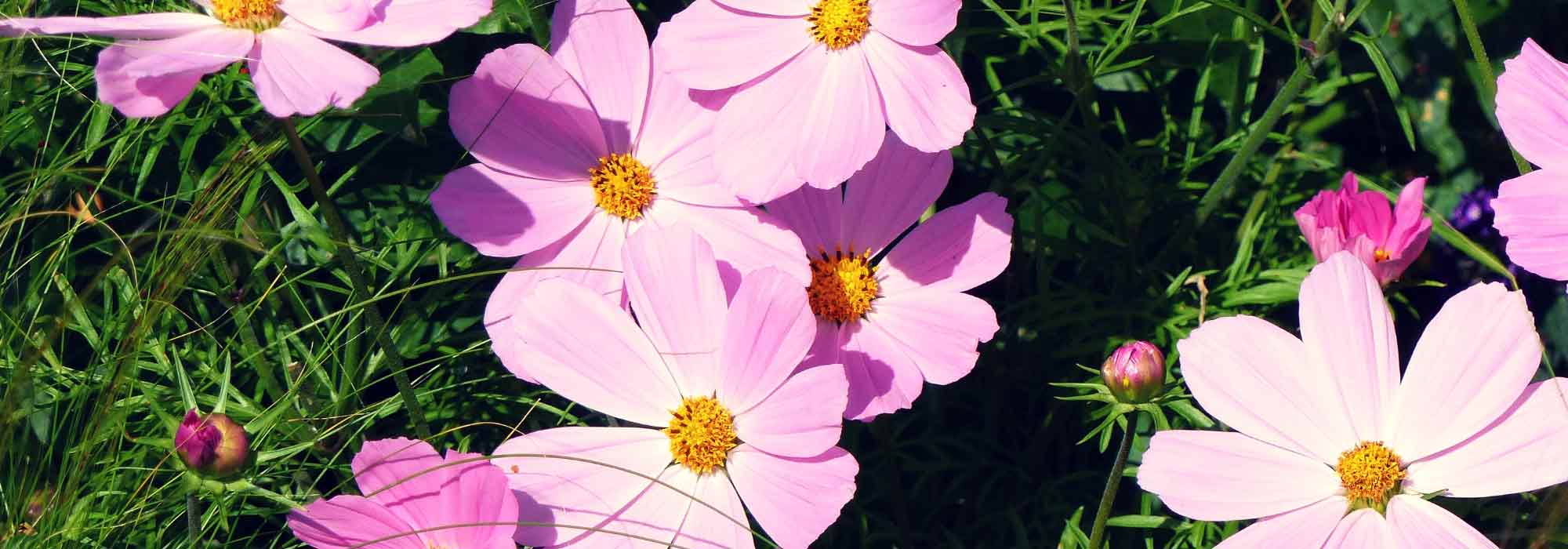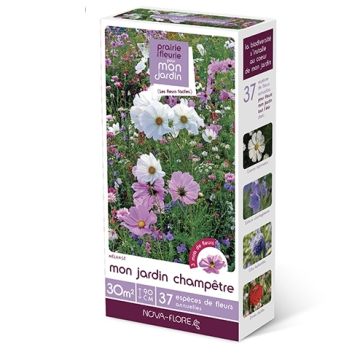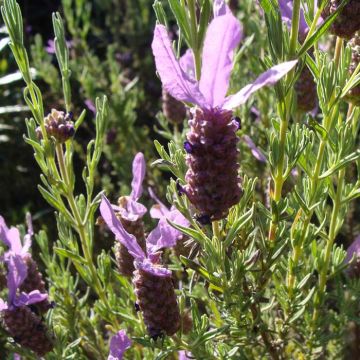

Cosmos Lucinda seeds - Cosmos bipinnatus
Cosmos Lucinda seeds - Cosmos bipinnatus
Cosmos x bipinnatus
Garden Cosmos, Mexican Aster
Special offer!
Receive a €20 voucher for any order over €90 (excluding delivery costs, credit notes, and plastic-free options)!
1- Add your favorite plants to your cart.
2- Once you have reached €90, confirm your order (you can even choose the delivery date!).
3- As soon as your order is shipped, you will receive an email containing your voucher code, valid for 3 months (90 days).
Your voucher is unique and can only be used once, for any order with a minimum value of €20, excluding delivery costs.
Can be combined with other current offers, non-divisible and non-refundable.
Why not try an alternative variety in stock?
View all →This plant carries a 6 months recovery warranty
More information
We guarantee the quality of our plants for a full growing cycle, and will replace at our expense any plant that fails to recover under normal climatic and planting conditions.
Does this plant fit my garden?
Set up your Plantfit profile →
Description
Cosmos bipinnatus Lucinda is a stately annual plant developed for bedding displays and cut flower arrangements. Its large, rounded pure white flowers, borne on long sturdy stems, possess a beautiful natural elegance. They are perfect for bringing a light and luminous touch to the garden throughout the summer.
Cosmos Lucinda germinates in spring, flowers in summer and then dies in autumn. This plant develops slender stems 1 m to 1.20 m in height. Its light green, finely cut and airy foliage showcases the abundance of summer flowers. The large, rounded, cup-shaped flowers measure 6 to 8 cm in diameter. They bloom from July to September in the case of a spring sowing. In mild climates or with an early sowing under cover, flowering can begin from late June and continue until October, especially if the weather remains mild. Regularly removing spent flowers encourages repeat flowering. Cosmos are loved by bees and other pollinators.
The bipinnate Cosmos 'Lucinda' combines harmoniously with other tall Cosmos varieties like 'Rubenza' or 'Sensation Pinkie'. Also pair it with tall cottage garden plants like Echinops bannaticus Blue Glow, Coneflowers, or ornamental grasses like Fountain Grasses. Sow your cosmos in a large seasonal border, a tall herbaceous border, or a flowering meadow.
The eco-friendly gesture: sowing a nectar-rich plant like Cosmos ‘Lucinda’ invites bees and other pollinators all summer long. At the end of the season, leave a few flowers to go to seed: they will feed the birds and promote the biodiversity of your garden.
Flowering
Foliage
Plant habit
Botanical data
Cosmos
x bipinnatus
Asteraceae
Garden Cosmos, Mexican Aster
Cultivar or hybrid
Planting and care
For Cosmos 'Lucinda', you have two sowing options:
Sow under cover in March-April followed by transplanting into pots before final placement in your borders after the frosts.
Direct sowing in situ in May (after the last frosts) followed by transplanting at a distance of 30 cm or simply thinning out excess seedlings. Allow between 80 and 90 days between sowing and flowering.
Germination takes 7 to 10 days at 15–20°C.
Soil preparation and sowing: cosmos prefers a light, well-drained soil, even poor, but not too moist. Choose a location in full sun. Loosen the soil to a depth of 15 to 20 cm, without adding too much fertiliser (soil that is too rich promotes foliage at the expense of flowers). Space young plants 30 to 40 cm apart.
Sowing period
Intended location
Planting & care advice
This item has not been reviewed yet - be the first to leave a review about it.
Similar products
Haven't found what you were looking for?
Hardiness is the lowest winter temperature a plant can endure without suffering serious damage or even dying. However, hardiness is affected by location (a sheltered area, such as a patio), protection (winter cover) and soil type (hardiness is improved by well-drained soil).

Photo Sharing Terms & Conditions
In order to encourage gardeners to interact and share their experiences, Promesse de fleurs offers various media enabling content to be uploaded onto its Site - in particular via the ‘Photo sharing’ module.
The User agrees to refrain from:
- Posting any content that is illegal, prejudicial, insulting, racist, inciteful to hatred, revisionist, contrary to public decency, that infringes on privacy or on the privacy rights of third parties, in particular the publicity rights of persons and goods, intellectual property rights, or the right to privacy.
- Submitting content on behalf of a third party;
- Impersonate the identity of a third party and/or publish any personal information about a third party;
In general, the User undertakes to refrain from any unethical behaviour.
All Content (in particular text, comments, files, images, photos, videos, creative works, etc.), which may be subject to property or intellectual property rights, image or other private rights, shall remain the property of the User, subject to the limited rights granted by the terms of the licence granted by Promesse de fleurs as stated below. Users are at liberty to publish or not to publish such Content on the Site, notably via the ‘Photo Sharing’ facility, and accept that this Content shall be made public and freely accessible, notably on the Internet.
Users further acknowledge, undertake to have ,and guarantee that they hold all necessary rights and permissions to publish such material on the Site, in particular with regard to the legislation in force pertaining to any privacy, property, intellectual property, image, or contractual rights, or rights of any other nature. By publishing such Content on the Site, Users acknowledge accepting full liability as publishers of the Content within the meaning of the law, and grant Promesse de fleurs, free of charge, an inclusive, worldwide licence for the said Content for the entire duration of its publication, including all reproduction, representation, up/downloading, displaying, performing, transmission, and storage rights.
Users also grant permission for their name to be linked to the Content and accept that this link may not always be made available.
By engaging in posting material, Users consent to their Content becoming automatically accessible on the Internet, in particular on other sites and/or blogs and/or web pages of the Promesse de fleurs site, including in particular social pages and the Promesse de fleurs catalogue.
Users may secure the removal of entrusted content free of charge by issuing a simple request via our contact form.
The flowering period indicated on our website applies to countries and regions located in USDA zone 8 (France, the United Kingdom, Ireland, the Netherlands, etc.)
It will vary according to where you live:
- In zones 9 to 10 (Italy, Spain, Greece, etc.), flowering will occur about 2 to 4 weeks earlier.
- In zones 6 to 7 (Germany, Poland, Slovenia, and lower mountainous regions), flowering will be delayed by 2 to 3 weeks.
- In zone 5 (Central Europe, Scandinavia), blooming will be delayed by 3 to 5 weeks.
In temperate climates, pruning of spring-flowering shrubs (forsythia, spireas, etc.) should be done just after flowering.
Pruning of summer-flowering shrubs (Indian Lilac, Perovskia, etc.) can be done in winter or spring.
In cold regions as well as with frost-sensitive plants, avoid pruning too early when severe frosts may still occur.
The planting period indicated on our website applies to countries and regions located in USDA zone 8 (France, United Kingdom, Ireland, Netherlands).
It will vary according to where you live:
- In Mediterranean zones (Marseille, Madrid, Milan, etc.), autumn and winter are the best planting periods.
- In continental zones (Strasbourg, Munich, Vienna, etc.), delay planting by 2 to 3 weeks in spring and bring it forward by 2 to 4 weeks in autumn.
- In mountainous regions (the Alps, Pyrenees, Carpathians, etc.), it is best to plant in late spring (May-June) or late summer (August-September).
The harvesting period indicated on our website applies to countries and regions in USDA zone 8 (France, England, Ireland, the Netherlands).
In colder areas (Scandinavia, Poland, Austria...) fruit and vegetable harvests are likely to be delayed by 3-4 weeks.
In warmer areas (Italy, Spain, Greece, etc.), harvesting will probably take place earlier, depending on weather conditions.
The sowing periods indicated on our website apply to countries and regions within USDA Zone 8 (France, UK, Ireland, Netherlands).
In colder areas (Scandinavia, Poland, Austria...), delay any outdoor sowing by 3-4 weeks, or sow under glass.
In warmer climes (Italy, Spain, Greece, etc.), bring outdoor sowing forward by a few weeks.




























































